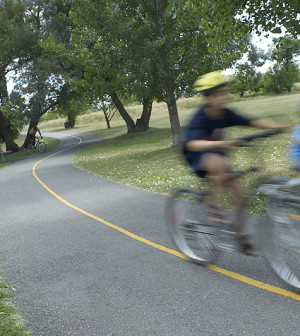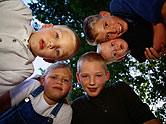- Navigating Your Midlife Crisis: Embracing New Possibilities
- City Raccoons Showing Signs of Domestication
- Mapping the Exposome: Science Broadens Focus to Environmental Disease Triggers
- One Week Less on Social Media Linked to Better Mental Health
- Your Brain Changes in Stages as You Age, Study Finds
- Some Suicide Victims Show No Typical Warning Signs, Study Finds
- ByHeart Formula Faces Lawsuits After Babies Sickened With Botulism
- Switch to Vegan Diet Could Cut Your Greenhouse Gas Emissions in Half
- Regular Bedtime Does Wonders for Blood Pressure
- Dining Alone Could Mean Worse Nutrition for Seniors
Parents, Stop Hovering: ‘Risky’ Play May Have Benefits for Kids


Children may benefit, physically and socially, from being allowed to play with less monitoring from mom and dad, a new research review finds.
There was a time when parents sent their kids outside to play, with the instruction to ‘”just be home by dinner.” Times have changed, however, and worries over children’s safety — whether it’s being injured, or harmed by a stranger — have led to kids having more structured activities, and less “free play.”
But there is such a thing as too much caution, experts say.
The new review found that when kids were allowed to play in ways that involved some sense of “risk” — such as climbing trees or exploring their neighborhood — it seemed to benefit their development.
The study also found that those kids got more physical activity than children whose playtime was less adventurous.
“That just makes sense. Kids who are outdoors more often are just naturally more active,” said lead researcher Mariana Brussoni, an assistant professor at the University of British Columbia’s School of Population & Public Health, in Vancouver, Canada.
But along with the physical benefits, more-adventurous play can help children take important steps in their social development, Brussoni said.
When there is no adult in charge, she explained, “children learn how to negotiate with each other, how to get along, and how to make their own rules.”
Even “rough-and-tumble” activities, like wrestling or play-fighting, may help kids learn to get along, the review found. At the very least, they do not seem to turn children into bullies.
According to Brussoni, that’s not surprising. “Rough-housing is different from fighting or bullying,” she said. “It’s not about one child trying to dominate another. There’s negotiation going on. You adjust your behavior and strength to the other child’s.”
The review, published online recently in the International Journal of Environmental Research and Public Health, included 21 previously published articles with about 50,000 kids from eight countries looking at different types of “risky” play. Children in those studies ranged from ages 7 to 15.
Essentially, Brussoni said, “it’s the kind of play we all remember from childhood — climbing trees, riding your bike fast, roaming the neighborhood with no direct adult supervision.”
Overall, the review found that such free play did not put kids in any particular danger. One study found that the risk of injuries requiring medical attention was lower during kids’ free-play hours, compared with sports.
A child psychiatrist who was not involved in the research agreed that free play is crucial for kids.
“There’s a lot of good research showing the value of ‘uninterrupted play,’ ” said Rebecca Berry, of the Child Study Center at NYU Langone Medical Center, in New York City.
“Uninterrupted” means that parents let their child get dirty, climb equipment in the playground, or get themselves out of a minor scrape — without immediately trying to intervene.
Kids need activities that are not led by an adult to truly learn, according to Berry. “Peer-group play is so important,” she said. “That’s how kids learn to take turns and figure out they can’t always go first. They learn to handle their emotions and deal with disappointment.”
If adults are always leading playtime and telling kids the rules, Berry said, children may start to rely on that “external source,” instead of gaining confidence in themselves.
Of course, parents should make sure their kids are in a safe environment, both Berry and Brussoni said. If parents live in an urban neighborhood, or a suburban one without sidewalks or with heavy traffic, they might not be able to let their kids roam.
But parents could relax a bit when they take their kids to the park, for example.
“You often hear parents in the playground saying, ‘No, get down! No, that’s too high!’ ” Brussoni said. “But it’s important to give your kids some space to explore and make decisions, and learn to problem-solve.”
Still, every child is different, and parents do have to consider their child’s “competence,” Berry said. If your child is naturally a big risk-taker, she noted, he or she may need some extra monitoring and guidance on how to stay safe.
But if parents never allow their children to take a chance on falling, or scraping a knee, or having their feelings hurt, they could send some negative messages, Berry explained.
Some children, she said, may learn to interpret every unknown as a danger, and to doubt their ability to deal with challenges. That’s a particular concern when a child has a naturally anxious temperament to begin with, Berry said.
Brussoni made another point: Children just need some breaks from taking instruction.
“Don’t we, as adults, need some time during the day where nobody is telling us what to do?” Brussoni said. “Why would kids be any different?”
More information
The Consumer Product Safety Commission has more on outdoor play safety.
Source: HealthDay
Copyright © 2025 HealthDay. All rights reserved.










